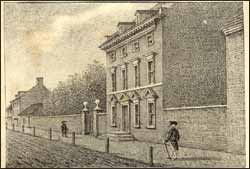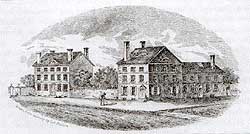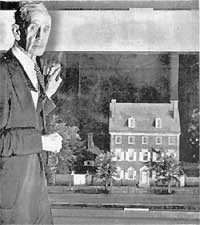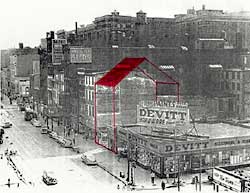Historiography of the President's House, 1832-1995
By Edward Lawler, Jr.
Why had you never heard of the President's House? You never heard of the President's House because most historians themselves know little or nothing about it. The mansion served as the 'White House' for the lion's shares of Washington's and Adams's presidencies, but much of what has been published about the building over the past 150 years has been erroneous. Conflicting opinions in the 19th century over where the house had stood, how large it had been, and what had been its appearance during its tenure as the Executive Mansion caused tremendous confusion. Original documents regarding the house existed — maps, deeds, insurance surveys, first-person accounts — but no one ever put all the pieces together, and successfully separated the fact from the fiction.

This view by William L. Breton was published in Watson's Annals in 1830. Two years later, the main house was demolished except for its side walls which survived as party walls shared with the adjoining buildings. Three narrow stores, 526-30 Market Street, were built within the same frontage as the main house and upon most of its original foundations.
–John Fanning Watson, Annals of Philadelphia (Philadelphia: 1830), p. 205.
Inaccuracies about the house were published as early as the 1830s, but the real tidal wave of misinformation began in the 1850s with a misguided antiquarian named Charles A. Poulson. He was convinced that the President's House had been a 5-bay, symmetrical-façade Georgian mansion (like Cliveden and Mount Pleasant), and that it had stood at 524-28 Market Street. He also claimed that much of the main house (the store at 524 Market Street, actually built in 1804) was still standing.
Poulson was wrong about the house's size, location, appearance and what was left of it; but he was persistent. He argued his opponents down, and presented intricate "proofs" based on his boyhood recollections, and those of others. His fantastical view of the house was published as an engraving in 1865, along with his spurious theories. Poulson died the following year, but within several decades his erroneous vision was accepted as the most accurate view of the President's House by the general public and even by most historians.

The Poulson sketch first appeared in William Brotherhead, ed., Sanderson's Biography of the Signers of the Declaration of Independence (Philadelphia: 1865), p. 337. Forty years later, it was the most frequently published view of the President's House.
–Harold Donaldson Eberlein, "190, High Street: The Home of Washington and Adams," in Historic Philadelphia, Luther P. Eisenhart, ed., Transactions of the American Philosophical Society, volume 43, part 1. (Philadelphia: 1953), p. 162.
In the 1930s, a team of architects and historians made an extensive study of the President's House under the aegis of the Works Progress Administration. An elaborate scale model of the house was designed and constructed based on the hundreds of pages of research notes the team amassed. (The WPA notes are in the collection of the American Philosophical Society in Philadelphia.) An unstated goal of the project was to call attention to the long-demolished mansion in the hope that money could be raised to build a full-sized re-creation (based on the model) in the national park being proposed for the area surrounding Independence Hall.
Researchers uncovered some of the original documents relating to the house, but those which contradicted the Poulson sketch seem to have been ignored. The WPA model, unveiled after nearly two years of work, was beautiful — exquisitely crafted and thoroughly convincing. Unfortunately, because of the shoddy scholarship behind it, the model was historically worthless.

More than 40 people worked on the WPA 'Models Project' between 1937 and 1939. Shown above is Charles Abell Murphy, the second project head. The President's House model was displayed in Washington, DC, and then given to the Atwater Kent Museum in Philadelphia. Photo courtesy of INHP Archives.
–Hannah Benner Roach, Historical Report: First Block, Independence Mall (Philadelphia Planning Commission, 1952), p. 23.
The WPA had missed the fact that some of the original walls were still standing in the 1930s, and the incompetence of the project's research and model only increased the confusion about the house. The buildings on the block directly north of Independence Hall were demolished in the early 1950s to create Independence Mall, including the surviving walls of the President's House. Despite the protests of the Philadelphia chapter of the American Institute of Architects, no archeological study was done of the site, and the foundations of the main house were cut down to 4 feet below ground level and reburied. A public restroom was erected where the 'White House' had stood.

This 1949 photo shows the surviving 4-story eastern wall and the "ghost" of the main house. Ten years earlier when the WPA made its study, it is likely that the 4-story western wall was also intact. From The Evening Bulletin Collection, Urban Archives, Temple University.
—Final Report to the United States Congress by the Philadelphia National Shrines Park Commission, (Philadelphia: 1947), v. 1, p. 269. This report became the basis for the Congressional legislation under which Independence National Historical Park was created.
The confusion over the President's House led to its surviving walls not being recognized for what they were, and resulted in their 1951 demolition. To give an idea of just how much confusion there was, let's try to answer something as simple as "where did the house stand?" Some of the choices:
Correct Location:
- 526-30 Market St. / 190 High Street / Market St. between 5th and 6th, south side.
Incorrect Locations:
- Chestnut St. below 6th, south side — William Sullivan, Familiar Letters on Public Characters and Public Events (Boston, 1834), p. 89. This would have put the President's House where Independence Hall stands. Sullivan's son corrected the error in later editions of the book.
- Front & Market Sts., SE corner — 190 High Street Research Data, 1937-38, WPA Project #13341, Manuscript Dept., American Philosophical Society, sheet #2. The Bank House is misidentified as the President's House. The error was later corrected.
- 242 S. 3rd St. — Ethel Armes, ed., Nancy Shippen, Her Journal Book (Philadelphia, 1935), pp. 68-69. Washington lived in this house for several months in late 1781 and early 1782 following the Siege at Yorktown, but he never lived here as President.
- 4th St. below Market St., east side — A 1908 Smith Ale calendar misidentifies the Indian Queen Hotel as the President's House.
- 518 Market St. — 190 High Street Research Data, Introduction to the research data. Based on the shoddy research of Charles Abell Murphy, the WPA places the President's House at the center of the block between 5th and 6th, in what would have been the walled garden. The error was later corrected.
- 524-28 Market St. — Poulson misidentifies 524 Market St. as the eastern portion of the President's House on the verso of his 1850 watercolor in the collection of the Library Company of Philadelphia. He makes the same erroneous assertion in the introduction to Sanderson's Biography of the Signers (1865).
- 526-28 Market Street — H. L. Freking, "The Third Presidential Mansion, 190 High Street, now 526-528 Market Street, Philadelphia, copyright 1938." Caption on a published pencil sketch related to the WPA research project.
- 528-30 Market St. — This address, which would have given the President's House a 32-foot frontage, is implied in Rufus Wilmot Griswold, The Republican Court, (New York, 1856), p. 240. The exact address is specified in John W. Jordan, Encyclopedia of Pennsylvania Biography, v. 13, p. 162.
- 532-34 Market St. — Joseph H. Appel, The Business Biography of John Wanamaker, (New York, 1930), p. 41.
- 225 S. 8th St. — Joseph A. Kilcullen, Your Friendly Guide to Philadelphia (Woodstown, NJ: 1948), p. 89. The Reynolds-Morris Mansion had no connection with Robert Morris (different family) or President Washington. This error is not infrequent.
- 9th St. between Chestnut and Market Sts., west side — Page Smith, John Adams (New York, 1962), pl. 23. This is the most frequently-made error by historians and others — i.e. mistaking the Presidential Mansion on 9th St. (which no president ever occupied), for the President's House on Market Street (where Washington and Adams actually lived).




